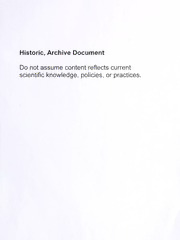
Elimination in linear editing and error localization / Stanley S. Weng. PDF
Preview Elimination in linear editing and error localization / Stanley S. Weng.
Historic, Archive Document Do not assume content reflects current scientific knowledge, policies, or practices. (\J 2 "7 CtTyvj Z' USDA Elimination in Linear Editing and Error United States Department of Localization Agriculture Stanley S. Weng National Agricultural Statistics Service Research and Development Division RDD Research Report Number RDD-02-06 October 2002 D The views expressed herein are not necessarily those of NASS or USDA. This report was prepared for limited distribution to the research community outside the U.S. Department of Agriculture. EXECUTIVE SUMMARY To improve the computational efficiency in developing an editing and imputation (E/I) error localization module for the U.S. Census of Agriculture and other large surveys conducted by NASS, we addressed the methodological issue of variable elimination by equality edit in linear editing. This will simplify the linear edit system and reduce the magnitude of computation. Though, in linear programming, the Fourier elimination method for linear inequalities has long been used, the role of equality edits in linear editing has not been fully explored. All the automatic computer E/I systems for numerical data have generally treated equality edits as a special case of inequality edits. A common practice has been to represent an equality edit by two inequalities of opposite direction. However, an equality edit defines a more informative relationship than an inequality edit. Therefore, the contribution of an equality edit to an editing problem should be more than that of an inequality edit. Our research results, extending some of Fellegi and Holt (1976) results on linear edits, establish the methodology of variable elimination by equality edit in linear editing, which leads to a simplified linear editing problem in reduced dimension. The methodological establishment of this paper can be particularly useful for the U.S. Census of Agriculture editing and imputation, for which a considerable number of the linear edits are equality ones. It is expected that the implementation of this methodology, in conjunction with other computational improvements, may enable Fellegi-Holt methodology to be implemented into the editing systems for future censuses and sample surveys with improved efficiency and accuracy. RECOMMENDATIONS The Census of Agriculture requires a very extensive editing system, featuring a large number of equality edits. As a result, the variable elimination methodology provided by this paper can be especially useful in the context of researching the possible incorporation of error-localization into the editing system for the 2007 Census of Agriculture. The following steps for further research are recommended: 1) Develop an automated approach for implementing the proposed variable elimination approach from an initial set of linear edits. 2) Calculate the computational gains from implementing this methodology on the linear edits prepared specifically for the Census of Agriculture. i ELIMINATION IN LINEAR EDITING AND ERROR LOCALIZATION Stanley S. Weng This paper presents some theoretical findings from our recent methodological research addressing the issue of variable elimination by equality edit in linear editing. The research was motivated by seeking improvement of computational efficiency for error localization, when implementing an error localization module for the editing and imputation of NASS’ large surveys. Our results, extending some of Fellegi and Holt (1976) results on linear edits, establish the method of elimination by equality edit in linear editing, which leads to a simplified linear editing problem in reduced dimension. The methodological establishment of this paper can be particularly useful as applied to the U.S. Census of Agriculture editing and imputation, for which a considerable number of the linear edits are equality ones. It is expected that the implementation of this methodology, in conjunction with other computational improvements, may enable Fellegi-Holt methodology to be implemented into the editing systems for future censuses and sample surveys with improved efficiency and accuracy. KEY WORDS: Automatic editing and imputation; Fellegi-Holt methodology; Implied edit; Fourier elimination; Elimination by equality edit. 1. INTRODUCTION approach instead of a Chemikova’s algorithm¬ like process (Quere, 2000; Quere and De For the error localization (EL) problem in Waal, 2000); and even an entirely different automatic data editing and imputation (E/I) approach, while still in the spirit of F-H with linear edits under the Fellegi-Holt (F-H) (Bankier, 2000; Bankier, et ah, 2000). methodology (Fellegi and Holt, 1976), the linear programming approach provides proper One other consideration is to simplify the methods for solution (Rubin, 1975; Sande, linear edit system by using its special structure 1978; Schiopu-Kratina and Kovar, 1989). and features, to reduce the dimension of the However, in practice, the computational system and thus the magnitude of computation efficiency of error localization has been an for error localization. issue (Winkler, 1999; Winkler and Chen, 2002). Various efforts have been made to Edits used in economic surveys and improve the efficiency, including using an censuses, like those created by NASS/USDA algorithm other than Chemikova’s for linear for the U.S. Census of Agriculture, are programming, e.g., one based on Duffin’s primarily linear. They also contain a (1974) analysis of a system of linear considerable number of equality edits, for inequalities (Houbiers, 1999); a tree-search example balance edits, in which an aggregate variable is equal to the sum of its component Stanley S. Weng is a Mathematical Statistician at the variables. National Agricultural Statistics Service, 3251 Old Lee Highway, Room 305, Fairfax, VA 22030. The author wishes to thank Dr. Ton de Waal, Statistics Netherlands, for his very In the presence of equality edits in a linear helpful information and comments, provided in their edit system, it seems preferable to use the correspondences, regarding the issues addressed in this paper. equality edits to eliminate fields (variables), Thanks also to Dale Atkinson, Bob McEwen, Amie Wilcox, and other reviewers at NASS for their suggestions which have leading to a simplified system in reduced helped to improve the presentation of this paper. dimension. However, until now, none of the 1
